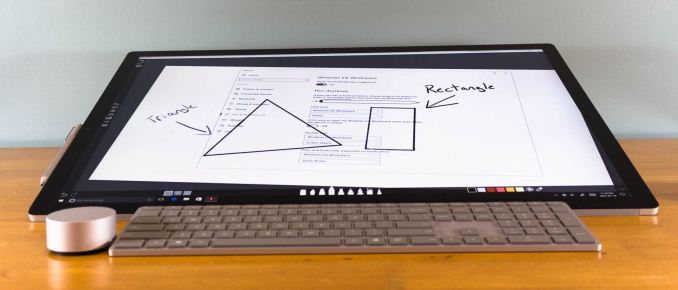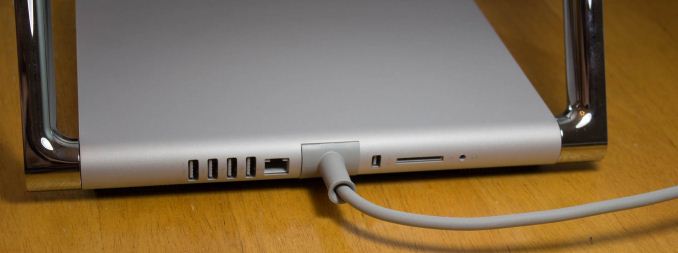The Microsoft Surface Studio Review
by Brett Howse on January 20, 2017 8:00 AM EST- Posted in
- Desktop
- Microsoft
- Surface
- Surface Studio
Design and the Zero-Gravity Hinge
Microsoft has built a brand around Surface, and that’s not an easy thing to accomplish. The Surface Studio fits in very well with the design ethos of the rest of the Surface lineup, and there has been quite a bit of attention to details paid in the creation of their first desktop computer. The first, and most obvious, is the finish, which matches perfectly with the other Surface devices, despite being made from aluminum rather than the magnesium alloy used on the portable products.
The 3:2 aspect ratio of the Surface Studio display is now a hallmark of the Surface brand (outside of Surface Hub), and having a taller display makes doing most tasks on a desktop a more pleasant experience. The increased surface area can’t be forgotten either, with the Surface Studio offering 17% more screen real estate than what's arguably the Studio's closest competitor, the 27-inch iMac, which amounts to an additional 54 square inches of display. Widescreen at 16:9 has never been a great aspect ratio for PC tasks, but the proliferation of high definition television seems to have moved the entire industry this way in an effort to save costs. When looking at the price of the Surface Studio, it’s important to remember that the entire display industry has moved to 16:9 as a standard, which impacts the entire supply chain and tooling required. Moving to an aspect ratio outside of 16:9 has large cost implications, but the end results are certainly worth it. Hopefully we will see a few other manufacturers use this as a means to source displays like this, much like the Surface Pro 3 and Pro 4 have ushered in more 3:2 devices at that much smaller size. And speaking of attention to detail, the Surface Studio is actually 28.125-inches diagonal, and as we'll see in a bit, that last 0.125-inches is very important.
It seems with Surface, Microsoft always wants to have a trick up their sleeve. With the original Surface RT and Surface Pro, it was the kickstand, which has been adopted by quite a few manufacturers for their own device since it works so well. When they launched their first laptop, the Surface Book, it was the muscle wire locking mechanism to remove the display from the base, as well as the dynamic fulcrum hinge to make the top-heavy laptop more stable. With the Surface Studio, the zero-gravity hinge is most definitely its signature design feature.
With two chrome arms flanking the base, the Surface Studio can almost effortlessly be folded down into a drafting table. The hinge mechanism provides a perfect counterbalance to the weight of the display, making it feel like it has almost no weight at all. The hinge is a single movement as well, so you don’t tip and fold the screen, but instead folding the screen also causes it to move down. While this does limit the functionality somewhat – for instance, you can't move the screen half way down and then fold it up straight again – the result is truly a wonderful design which almost needs to be seen in person.
Because you can’t tip the screen without folding it, once you stop at any angle, the screen is very solid to work with, although it is the most secure when folded all the way down to the 20° angle. You would think a large desktop display would not be ideal to use with touch, but the Surface Studio zero-gravity hinge invites you to be more interactive with it, by keeping the display close and folding it down when needed. More traditional all-in-one computers with a touch screen are nowhere near as easy to work with, since holding your arm in dead-air can be tiring, but the folded display doesn’t suffer from these burdens.
The PC base also exudes Surface quality, with the signature color, and cooling vents all the way around in the same fashion as the Surface Pro and Surface Book. The PC base can be disassembled from the bottom if required, for access to the storage and fans, but the remainder of the system is soldered to the board as you would expect in a small form factor device like this. The most frustrating part of the Surface Studio base is that all the inputs and outputs are on the rear of the device, so connecting something over USB, or inserting a SD card into the PC, is not as simple as it should be. This is a form over function decision, and it would be nice to see some of the ports offered at least on the side of the base to make it a bit easier to access.
The desktop PC market has not been as exciting to watch as the smaller and more portable laptops and tablets, but the Surface Studio sets a new high mark for desktop PC design and looks. Some of the decisions are form over function, but the majority of the design decisions actually improve the user experience. The zero-gravity hinge is a masterpiece of engineering, with such a smooth action that it really does feel like the display has no mass at all.













197 Comments
View All Comments
Manch - Sunday, January 22, 2017 - link
Yup. Also, you could if you really needed the additional computing power of a newer box just run an app remotely.lilmoe - Sunday, January 22, 2017 - link
CPUs are one thing, and so is storage (somewhat). But what about the GPU? RAM? PORTS?Your argument would have been someone acceptable if the Studio had more expandability options as I mentioned in the other 2 points.
Icehawk - Sunday, January 22, 2017 - link
Heck, more like 6 at this point.Gadgety - Friday, January 20, 2017 - link
Exactly. I know the base will age very quickly, preaged, even, but I still want one even it if it's just to browsethe web, browse and control my media and playing with occasional drawing. So Microsoft has succeeded in creating the want factor. That in itself is quite an achievement. I won't be getting one, though. Now, I might have if the base was upgradeable, or even more likely, if the screen was sold separately.
melgross - Friday, January 20, 2017 - link
Well, see, here's the problem. You say that you want one, but that you won't get one. That's what most people will be saying.Brett Howse - Friday, January 20, 2017 - link
That's what want means. Otherwise you'd say havevoicequal - Saturday, January 21, 2017 - link
Doesn't much matter who wants one - Microsoft store is showing two month lead times on the two low end models, and a five month lead time on the high end i7.jvl - Friday, January 20, 2017 - link
Is there an array of microphones in there somewhere?Seems like a really nice machine. Bit expensive, but surely something I'd like on my desk ;-)
Brett Howse - Friday, January 20, 2017 - link
Yes there are two microphones in the display as well.Tegeril - Friday, January 20, 2017 - link
Out of curiosity, why no display calibration (brightness, contrast, uniformity...) comparisons to iMac/MacBook Pro?